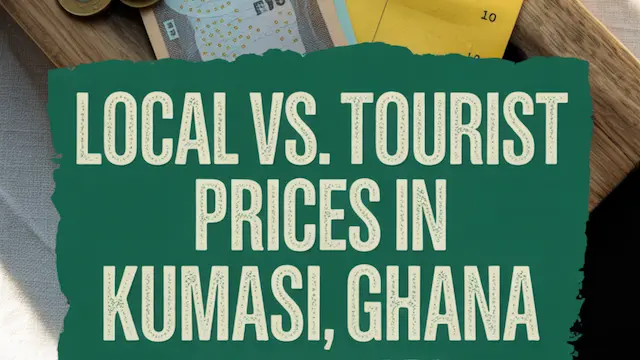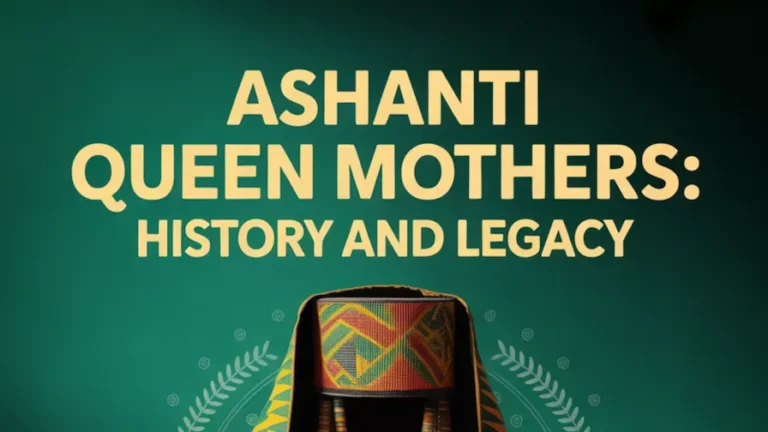Dual Pricing for Kumasi and Ashanti Region Tourism in Ghana: Essential and Fair Explanation

When visiting popular attractions in Ghana, including well-known sites in Kumasi and across the Ashanti Region, you might notice two sets of prices.
One is for Ghanaian nationals, and another is for non-nationals.
Tourists and non-local residents may already be familiar with sellers charging higher prices in markets or taxis.
This often happens because sellers assume visitors have more money, are less familiar with local rates, and may not negotiate.
Dual pricing at attractions is different. It is an official system with clear goals that benefit both locals and visitors.

Struggling to Keep Track of All Your Kumasi Adventures? No worries!
With so much to see, do, and learn in Kumasi, it’s easy for the details to get lost. Want to make the most of your explorations? Then you need this FREE Kumasi Journal Set!
It’s perfect for recording your favorite spots, and cultural experiences, and even learning key Twi words and phrases to deepen your connection to Kumasi. Whether you’re a local or a visitor, this journal makes every moment count.
What Dual Pricing Means
Dual pricing means the entry fee depends on whether you are a citizen or a foreign visitor. For example, at the Kumasi Zoo:
- Nationals: GHC 20 for adults, GHC 5 for children
- Non-nationals: GHC 60 for adults, GHC 30 for children
The difference helps keep attractions affordable for locals while ensuring enough funding to maintain the site.
Why Nationals Pay Lower Fees
Lower entry fees for Ghanaian citizens are part of a tourism policy aimed at making cultural and natural sites more accessible. The focus is on giving locals the chance to visit often without cost being a barrier.
Keeping Attractions Accessible
Lower prices help families, schools, and community groups visit without financial strain. For example, schools often take students to the Kumasi Zoo for field trips. These trips play an important role in learning about wildlife and conservation.
Encouraging Cultural Connection
Museums, historic sites, and cultural landmarks hold deep meaning for locals. Affordable fees allow more people from all over the region to engage with their history and traditions.
Promoting Domestic Tourism
By making prices affordable for nationals, Ghana encourages its citizens to explore the country’s natural and cultural sites more often.

Why Non-Nationals Pay More
Higher rates for international visitors help generate the funds needed to maintain and improve attractions. These fees also follow global tourism standards while supporting local economies.
Funding Conservation and Upkeep
Attractions like the Kumasi Zoo or Bonwire Museum require ongoing care for animals, maintenance of facilities, and payment for staff. Fees from non-nationals help fund these needs.
Following International Standards
Many countries have similar systems. For example, Kenya, India, and Thailand also set different rates for citizens and foreign visitors. Ghana’s rates remain affordable compared to many global attractions.
Contributing to the Local Economy
Tourism is a key part of Ghana’s economy. Higher fees from non-nationals help improve infrastructure and support community projects.
Ethical and Practical Benefits
Dual pricing also helps reduce overcrowding and strain on resources. By balancing access for locals with financial contributions from visitors, Ghana keeps attractions enjoyable and sustainable.
How the Revenue is Used
Money from entry fees is reinvested in the attraction and its surrounding communities. It helps keep the site running, protects its natural or cultural value, and supports programs that benefit both visitors and locals.
Funds from entry fees are often used for:
- Conservation: Protecting wildlife and natural habitats.
- Education: Programs for school groups to learn about history, culture, and the environment.
- Maintenance: Keeping facilities safe and welcoming.
- Community Development: Supporting local projects near the attractions.
Education Through Field Trips
Many Ghanaian schools include trips to sites like the Kumasi Zoo in their programs. These visits help students learn about conservation, history, and cultural pride.
Affordable entry ensures that children from different backgrounds can benefit from these opportunities.
Enjoying This Post? Keep Exploring With Us!
If this post connects with you, check out our store for fun and interactive ways to explore Kumasi, the Ashanti Kingdom, and the Ashanti Region. From history and culture to beginner-friendly Twi language learning, we’ve created resources to help you learn, connect, and share.

How Other Countries Use Dual Pricing in Tourism
Dual pricing is common in parts of Africa, Asia, and the Middle East, but less common in the US, the UK, and much of Europe.
In those regions, attractions typically charge a single standard price for all visitors.
Some may offer occasional discounts to residents, members of loyalty programs, local clubs, or annual pass holders, but these are optional perks or marketing offers, not a nationwide policy.
- Kenya: Higher fees for foreign visitors at national parks like the Maasai Mara.
- India: Reduced rates for Indian citizens at historic landmarks, such as the Taj Mahal.
- Thailand: Local rates at national parks and temples for Thai residents.

Visiting Tips for Kumasi and Ashanti Region Attractions
If you are visiting Kumasi or other sites in the Ashanti Region, a few simple steps can help you make the most of your trip and support the communities that manage these attractions.
- Check Fees Ahead of Time: Many attractions in Kumasi and across Ghana share their rates online or at the entrance.
- Carry Cash: Entry fees are usually paid in cash, so have smaller notes ready for easy payment.
- Understand Why Prices Differ: Paying the non-national rate helps fund conservation projects, maintain facilities, and create educational programs.
- Respect Local Hospitality but Support the Cause: Some locals may offer to pay your entry fee at the national rate as a friendly gesture. While this is common, choosing to pay the non-national rate helps ensure these sites continue to thrive for future visitors.
💡 Did You Know?
Ghana’s currency is the Ghanaian cedi (GHS). Entry fees at attractions are mostly listed in cedis, and cash is the most common payment method. Having smaller notes, such as 5, 10, and 20 cedis, makes paying for tickets safe, faster and easier.
Dual pricing in Ghana strikes a balance between affordability for locals and the need to fund conservation and tourism services.
For nationals, it makes cultural and natural sites easier to visit. For non-nationals, it provides an opportunity to contribute to the preservation of Ghana’s heritage and biodiversity.
When you pay an entry fee, you are helping to protect these spaces, improve facilities, and create benefits for surrounding communities.
Frequently Asked Questions About Dual Pricing in Ghana
Do all attractions in Ghana use dual pricing?
No. Some attractions have a single fee for everyone, while others use dual pricing for sustainability and access.
Is dual pricing legal in Ghana?
Yes. It is an accepted tourism policy in many countries, including Ghana.
Can a foreign resident in Ghana pay the national rate?
Some attractions allow this if you show proof of residency. Always check with the ticket office.
Why do prices differ so much between nationals and non-nationals?
The higher fees for non-nationals reflect the need for funding, while lower fees help locals afford regular visits.
Does the extra fee for non-nationals go directly to the attraction?
In most cases, yes. It supports the operation, maintenance, and development of the site.
AKWAABA!! IF THIS POST CAPTURED YOUR ATTENTION, KEEP EXPLORING KUMASI WITH US AT ExploreKumasi.com. Yɛdaase!
You’ll find cultural guides, historical insights, and travel resources to help you experience Kumasi and the Ashanti Region more deeply.
💬 Want to stay connected? Join our community on Facebook to share your thoughts and discoveries.
📌 Inspired by what you read? Pin an image to come back later or share with someone planning their own Kumasi journey.
Thank you for exploring with us.






